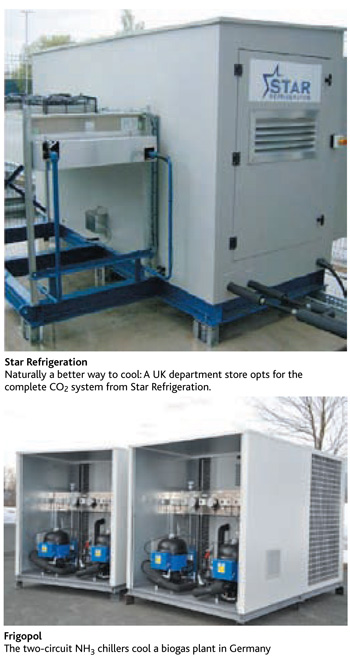With new components and applications emerging, systems with small capacities can be successfully implemented using natural coolants, such as ammonia or carbon dioxide, believes eurammon, and cites case studies as evidence.
With new components and applications emerging, systems with small capacities can be successfully implemented using natural coolants, such as ammonia or carbon dioxide, believes eurammon, and cites case studies as evidence.
Background
 Natural refrigerants now have a firm place in the market as an environmentally friendly solution for industrial refrigeration. In view of legal directives and increasing ecological awareness on the part of operators and customers, the market is becoming more dynamic – new components are being developed and new applications installed. This does not only apply to refrigeration plants with a large capacity but also more and more to smaller capacity ranges, such as those found in deep-freeze rooms.
Natural refrigerants now have a firm place in the market as an environmentally friendly solution for industrial refrigeration. In view of legal directives and increasing ecological awareness on the part of operators and customers, the market is becoming more dynamic – new components are being developed and new applications installed. This does not only apply to refrigeration plants with a large capacity but also more and more to smaller capacity ranges, such as those found in deep-freeze rooms.
Even though many end-users still rely on synthetic refrigerants, there are already signs that these preferences will be redefined in future. In fact, this will be in favour of natural refrigerants, as their potential, especially for refrigeration systems with smaller capacity ranges, is enormous. It is not without reason, for example, that carbon dioxide has already been successfully used as a refrigerant in the deep-freeze area of many supermarkets for over 10 years. Ammonia too, which until now has predominantly been used in systems over 100 kW, appears increasingly attractive for smaller systems. This is shown by the following case studies and experiences of eurammon members Frigopol, Star Refrigeration and HKT Huber-Kälte-Technik.
Frigopol cools biogas plant in Germany with ammonia
Frigopol Kälteanlagen GmbH, based in the Austrian town of Frauental, is an expert for small production runs and has been making special refrigeration and air conditioning solutions for over 60 years. For this purpose, the traditional company relies on natural refrigerants – for the sake of the environment. This was also clear to the operators of a biogas plant right from the start: The intention was to design their refrigeration to be environmentally friendly and in accordance with sustainability principles. Frigopol installed two dual-circuit refrigeration systems with ammonia and a capacity of 2 * 20 and 2 * 100 kw respectively. The system is used to cool the biogas plant’s gas motors and keep the process water at a temperature between +2°C and +6°C at all times.
Frigopol’s many years of experience and its expertise in the construction of small production runs using NH3 made it perfectly feasible to implement the project with low capacities. With a total of eight separating hood compressors from Frigopol, as well as suitable plate heat exchangers from Alfa Laval, dry coolers from Güntner, condensers from Thermofin, valves from Danfoss and oil separators from Klimal, Frigopol was able to successfully implement the refrigeration system.
“We believe that the demand for applications in the low-capacity range will continue to grow.” says Johan. “After all, such an eco-efficient solution is ideal for many areas in the food and non-food sector. That applies both to industrial and commercial use.” If a position outdoors could be ensured, using an indirect refrigeration system with ammonia would also be practicable in sectors like the hotel and gastronomy trade.
UK department store opts for CO2 in small refrigeration rooms
 An internationally renowned department store in London was also looking for an environmentally friendly and efficient refrigeration plant for the newly developed Thames Valley distribution centre, Thatcham. The aim was to cool two small refrigeration rooms used for drinks and perishable foods. The department store contracted Star Refrigeration to plan this system. As a special solution for the small refrigeration rooms, the refrigeration specialist developed a customised carbon dioxide refrigeration plant. The single-stage transcritical plant has a capacity of 20 kw and is equipped with an Envichill DX system. With the aid of the carbon dioxide gas cooler, plus several compressors and an efficient evaporator control system using electronic expansion valves, the plant keeps both refrigeration rooms at a constant +4°C even in the middle of summer.
An internationally renowned department store in London was also looking for an environmentally friendly and efficient refrigeration plant for the newly developed Thames Valley distribution centre, Thatcham. The aim was to cool two small refrigeration rooms used for drinks and perishable foods. The department store contracted Star Refrigeration to plan this system. As a special solution for the small refrigeration rooms, the refrigeration specialist developed a customised carbon dioxide refrigeration plant. The single-stage transcritical plant has a capacity of 20 kw and is equipped with an Envichill DX system. With the aid of the carbon dioxide gas cooler, plus several compressors and an efficient evaporator control system using electronic expansion valves, the plant keeps both refrigeration rooms at a constant +4°C even in the middle of summer.
“The customer was looking for a future-proof solution with natural refrigerants,” says Andy Butler, Retail Manager at Star Refrigeration. “With the energy-efficient carbon dioxide refrigeration system, we have enabled the customer to reduce its carbon footprint and prevent any negative effects in terms of global warming and ozone depletion. The result is quite astounding: Our system helped the famous department store achieve a high BREEAM assessment, an ecological evaluation for sustainable buildings, with its new distribution centre.”
High energy-efficiency in small capacity ranges
The two practical examples make it quite clear: Systems with small capacities can be successfully implemented using natural coolants such as ammonia or carbon dioxide. Not only is this good for the environment, but it also allows energy-efficient refrigeration solutions.
“Above all, applications like cascade systems with carbon dioxide in the subcritical range for deep-freezing and with ammonia for normal refrigeration are very efficient,” Herunter explains. Karl Huber, Managing Director of HKT Huber-Kälte-Technik, also sees the benefits of CO2 in the low temperature level of cascades and subcritical applications. He says: “CO2 will establish itself especially for supermarket refrigeration. Installing an additional refrigeration unit or a pressure compensation container allows excess pressure build-up to be prevented on these systems, even in the event of a stoppage or fault.”
Set for the future with green refrigeration plants
Natural refrigerants, such as ammonia and carbon dioxide, are becoming increasingly important, especially in small application areas. For suppliers of innovative refrigeration systems, above all, this means a rapid growth in market potential. Current research, such as that carried out by Behzad Abholhassani Monfared, is also being focused on their use in residential buildings. Monfared, who took second place in the eurammon Natural Refrigeration Awards 2011, is developing an ammonia heat pump with seven kWh for a single-family house, as part of his research project.
“The demand for refrigeration using natural refrigerants is noticeably increasing,” explains Herunter. “After all, these systems are not only impressive in ecological, but also in economic terms. Higher acquisition costs than those for applications using synthetic refrigerants will be quickly recouped by considerably lower operating costs resulting from optimal technical design and dimensions.” Huber also sees further market opportunities in future: “With the development of innovative components, natural refrigerants can also be used where they are not yet so common. For the pilot project conducted by the student Behzad Abholhassani Monfared, we supplied a component that was fitted into the ammonia heat pump for a single-family house. We are convinced that many new applications with natural refrigerants will be prospectively put into place for private use, too.”
The development of refrigeration systems using natural refrigerants will, however, also largely depend on future ecological and political developments. The Montreal Protocol from 1987, and its ratifications, also promote the use of natural refrigerants. “Against this background, an environmentally friendly natural refrigerant should already take preference in any case – even if it is “only” as energy-efficient as a synthetic one,” Huber adds. To achieve this, however, the task remains to break down existing reservations towards natural refrigerants. “More clarification work is needed, especially when it comes to the end customers,” says Herunter, pointing out future potential for natural refrigerants in the end-customer business. “Around 70% of companies still do not know that there is an environmentally friendly alternative for their refrigeration plant, with which they can save hard cash in the long run.”
Copyright © 2006-2025 - CPI Industry. All rights reserved.